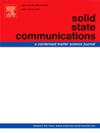强磁场下镓的定向凝固:核磁共振研究
IF 2.4
4区 物理与天体物理
Q3 PHYSICS, CONDENSED MATTER
引用次数: 0
摘要
强磁场下的定向凝固为金属和金属合金的重要特征开辟了裁剪技术的新视角。本文利用Avance 400核磁共振波谱仪证明了金属镓在结晶时的取向,这是由波谱仪的磁场引起的。大约三分之一的镓样品显示出晶体轴的特定取向。对α-Ga和亚稳态β-Ga均有影响。通过出现类似于镓单晶的窄核磁共振谱线,揭示了晶轴的取向。研究了α-Ga谱线频率的角依赖性,并考虑了四极耦合和Knight位移。结果表明,晶体a轴与磁场方向接近。发现磁场对结晶时镓取向的影响是可重复的。本文章由计算机程序翻译,如有差异,请以英文原文为准。
Directional solidification in gallium under strong magnetic field: NMR studies
Directional solidification in the strong magnetic field opens new perspectives in tailoring technologically important features of metals and metallic alloys. Here we use an Avance 400 NMR spectrometer to prove the orientation of metallic gallium upon crystallization, which was induced by the magnetic field of the spectrometer. About one third of the gallium sample was shown to have the particular orientation of the crystalline axes. The effect was observed for both α-Ga and metastable β-Ga. The orientation of the crystalline axes was revealed by the emergence of the narrow NMR lines similar to those in the gallium single crystals. The angular dependences of the NMR line frequencies were studied for α-Ga and were treated taking into account the quadrupole coupling and Knight shift. The crystalline a-axis was demonstrated to be aligned close to the magnetic field direction. The impact of the magnetic field on the gallium orientation at crystallization was found to be reproducible.
求助全文
通过发布文献求助,成功后即可免费获取论文全文。
去求助
来源期刊

Solid State Communications
物理-物理:凝聚态物理
CiteScore
3.40
自引率
4.80%
发文量
287
审稿时长
51 days
期刊介绍:
Solid State Communications is an international medium for the publication of short communications and original research articles on significant developments in condensed matter science, giving scientists immediate access to important, recently completed work. The journal publishes original experimental and theoretical research on the physical and chemical properties of solids and other condensed systems and also on their preparation. The submission of manuscripts reporting research on the basic physics of materials science and devices, as well as of state-of-the-art microstructures and nanostructures, is encouraged.
A coherent quantitative treatment emphasizing new physics is expected rather than a simple accumulation of experimental data. Consistent with these aims, the short communications should be kept concise and short, usually not longer than six printed pages. The number of figures and tables should also be kept to a minimum. Solid State Communications now also welcomes original research articles without length restrictions.
The Fast-Track section of Solid State Communications is the venue for very rapid publication of short communications on significant developments in condensed matter science. The goal is to offer the broad condensed matter community quick and immediate access to publish recently completed papers in research areas that are rapidly evolving and in which there are developments with great potential impact.
 求助内容:
求助内容: 应助结果提醒方式:
应助结果提醒方式:


